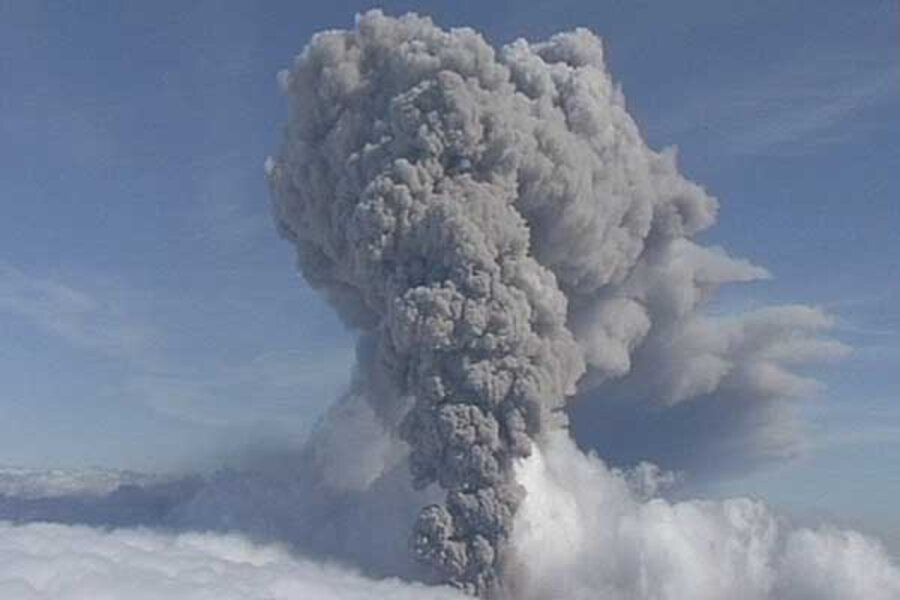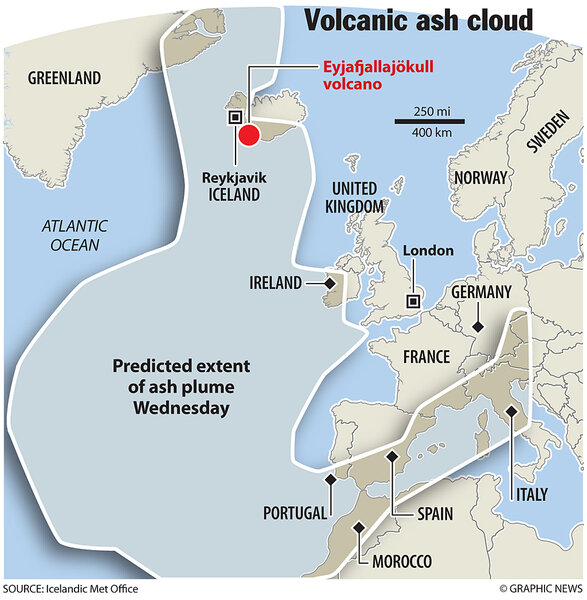Volcanic ash cloud: Where is it now?
After several weeks of relief, the volcanic ash cloud from Iceland has returned to European airspace, disrupting hundreds of flights. Now it's affecting Africa, too.
While Eyjafjallajokull (pronounced ay-yah-FYAH-lah-yer-kuhl) has never stopped spewing ash since its initial April 14 eruption caused a week-long suspension of air traffic in Europe, the resulting cloud had contained itself over the Atlantic Ocean and flights had returned to near normal until the weekend.
After a weekend of flight cancellations throughout Europe and North Africa, airports reopened Monday in Austria, Italy, Germany, Ireland, and Scotland. In Spain, 19 airports were closed over the weekend, and all but five reopened by Tuesday.
But the ash cloud continued to drift over the Iberian peninsula, keeping airports closed in Spain and Portugal on Tuesday and causing flight cancellations throughout Morocco and in parts of Turkey. Delays out of Gatwick Airport in London affected transatlantic flights to the United States, and Saudi Airlines said it had halted flights between the US and Saudi Arabia, Agence France-Presse reported.
European flight monitor Eurocontrol wrote on its website that it expects approximately 29,000 flights within Europe today, which it said is "close to normal for a Tuesday at this time of year." There were 29,155 flights on Monday. “Situation in your area is changing by the minute,” Eurocontrol said on its Twitter page. “Keep in touch with your airport / airline.”
Eurocontrol is tracking multiple ash clouds from the Icelandic volcano, defined by the altitude they inhabit. An ash cloud below 20,000 feet is roughly the same size as Europe. The cloud covers the southern half of Iceland and stretches thousands of miles south over the Atlantic Ocean. At the southern end of the cloud, a thin arm extends east over the Strait of Gibraltar and into Spain.
Between 20,000 and 35,000 feet there are three smaller ash clouds: one southwest of Ireland, one west of Morocco, and one directly over Spain and France.
Britain’s MET office is also mapping updates on the drifting ash cloud.
The current ash cloud affecting Europe was likely spewed weeks ago from the volcano. According to the Associated Press, the ash now drifting over Europe and Africa is left over from previous weeks and could remain in the atmosphere for weeks.
"We really don't know when it will settle down. So even if the volcano stops, we can look at this problem for a couple of weeks after," Bjoern Oddsson of the Institute of Earth Sciences at the University of Iceland, told the Associated Press.
A series of 40 earthquakes emanated from the volcano Monday morning, according to the daily report from the Icelandic Meteorological Office and Institute of Earth Sciences at the University of Iceland. This indicates that magma is still flowing in from the mantle.
"Presently there are no indications that the eruption is about to end," the agency said.
On Monday, the volcano was emitting about 50 tons of ash every second, down from 300 to 400 tons of ash per second last week, according to Agence France-Presse.
The six-day shutdown in April cost the European airline industry an estimated $1.7 billion, according to a report from the International Air Transport Association. Airline stocks have tumbled because of the affect on flights. The volcano has already cost EasyJet up to $110 million in losses. Stocks of EasyJet, Aer Lingus, and Ryanair all declined Tuesday on the London Stock Exchange.
Related:






